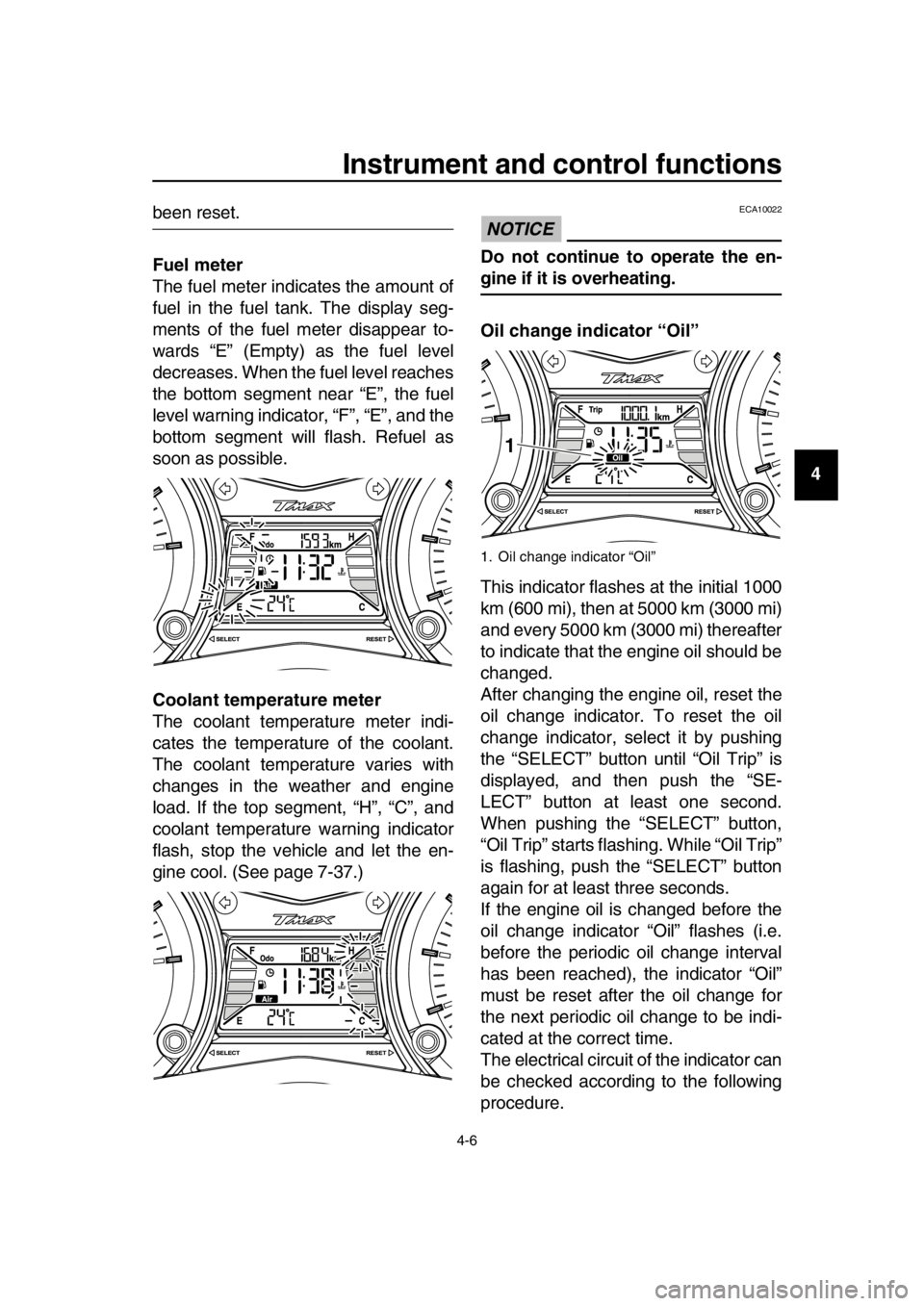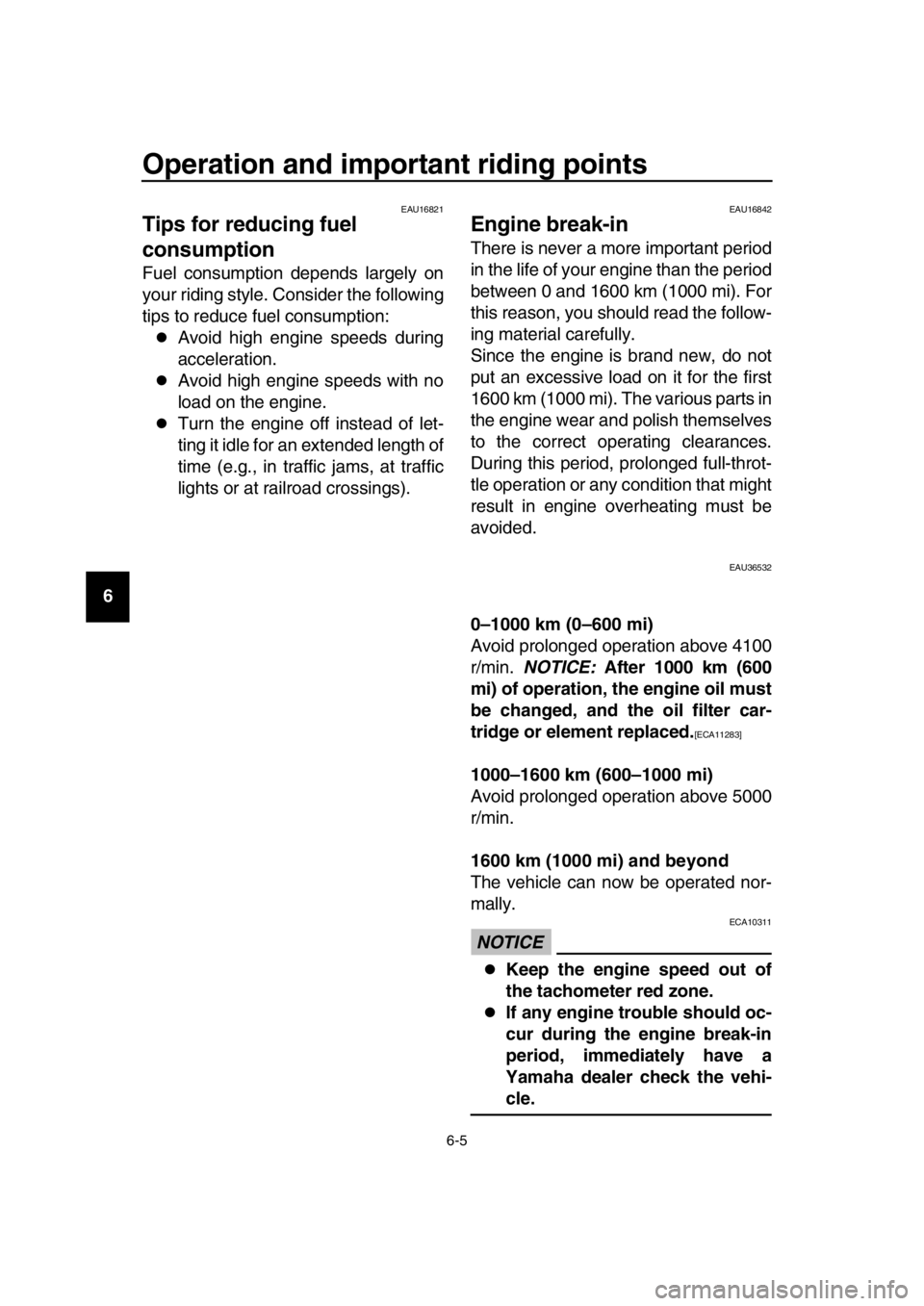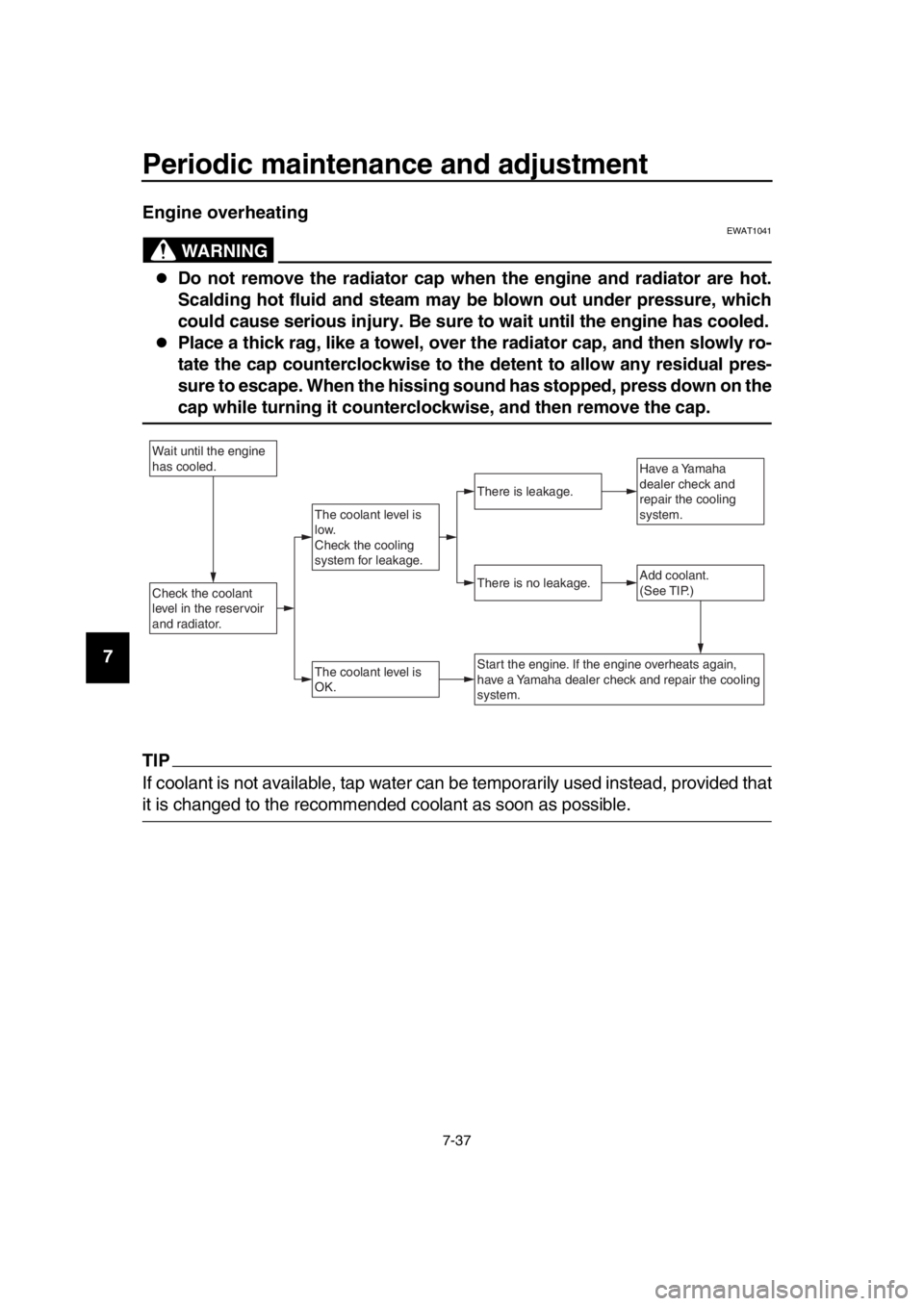engine overheat YAMAHA TMAX 2016 Owners Manual
[x] Cancel search | Manufacturer: YAMAHA, Model Year: 2016, Model line: TMAX, Model: YAMAHA TMAX 2016Pages: 110, PDF Size: 6.26 MB
Page 31 of 110

Instrument and control functions
4-6
1
2
3
4
5
6
7
8
9
10
11
12
13
14
been reset.
Fuel meter
The fuel meter indicates the amount of
fuel in the fuel tank. The display seg-
ments of the fuel meter disappear to-
wards “E” (Empty) as the fuel level
decreases. When the fuel level reaches
the bottom segment near “E”, the fuel
level warning indicator, “F”, “E”, and the
bottom segment will flash. Refuel as
soon as possible.
Coolant temperature meter
The coolant temperature meter indi-
cates the temperature of the coolant.
The coolant temperature varies with
changes in the weather and engine
load. If the top segment, “H”, “C”, and
coolant temperature warning indicator
flash, stop the vehicle and let the en-
gine cool. (See page 7-37.)NOTICE
ECA10022
Do not continue to operate the en-
gine if it is overheating.
Oil change indicator “Oil”
This indicator flashes at the initial 1000
km (600 mi), then at 5000 km (3000 mi)
and every 5000 km (3000 mi) thereafter
to indicate that the engine oil should be
changed.
After changing the engine oil, reset the
oil change indicator. To reset the oil
change indicator, select it by pushing
the “SELECT” button until “Oil Trip” is
displayed, and then push the “SE-
LECT” button at least one second.
When pushing the “SELECT” button,
“Oil Trip” starts flashing. While “Oil Trip”
is flashing, push the “SELECT” button
again for at least three seconds.
If the engine oil is changed before the
oil change indicator “Oil” flashes (i.e.
before the periodic oil change interval
has been reached), the indicator “Oil”
must be reset after the oil change for
the next periodic oil change to be indi-
cated at the correct time.
The electrical circuit of the indicator can
be checked according to the following
procedure.
1. Oil change indicator “Oil”
1
2PW-9-E1.book 6 ページ 2015年9月10日 木曜日 午後5時17分
Page 56 of 110

Operation and important riding points
6-5
1
2
3
4
5
6
7
8
9
10
11
12
13
14
EAU16821
Tips for reducing fuel
consumption
Fuel consumption depends largely on
your riding style. Consider the following
tips to reduce fuel consumption:
Avoid high engine speeds during
acceleration.
Avoid high engine speeds with no
load on the engine.
Turn the engine off instead of let-
ting it idle for an extended length of
time (e.g., in traffic jams, at traffic
lights or at railroad crossings).
EAU16842
Engine break-in
There is never a more important period
in the life of your engine than the period
between 0 and 1600 km (1000 mi). For
this reason, you should read the follow-
ing material carefully.
Since the engine is brand new, do not
put an excessive load on it for the first
1600 km (1000 mi). The various parts in
the engine wear and polish themselves
to the correct operating clearances.
During this period, prolonged full-throt-
tle operation or any condition that might
result in engine overheating must be
avoided.
EAU36532
0–1000 km (0–600 mi)
Avoid prolonged operation above 4100
r/min. NOTICE: After 1000 km (600
mi) of operation, the engine oil must
be changed, and the oil filter car-
tridge or element replaced.
[ECA11283]
1000–1600 km (600–1000 mi)
Avoid prolonged operation above 5000
r/min.
1600 km (1000 mi) and beyond
The vehicle can now be operated nor-
mally.
NOTICE
ECA10311
Keep the engine speed out of
the tachometer red zone.
If any engine trouble should oc-
cur during the engine break-in
period, immediately have a
Yamaha dealer check the vehi-
cle.
2PW-9-E1.book 5 ページ 2015年9月10日 木曜日 午後5時17分
Page 94 of 110

Periodic maintenance and adjustment
7-37
1
2
3
4
5
6
7
8
9
10
11
12
13
14 Engine overheating
WARNING
EWAT1041
Do not remove the radiator cap when the engine and radiator are hot.
Scalding hot fluid and steam may be blown out under pressure, which
could cause serious injury. Be sure to wait until the engine has cooled.
Place a thick rag, like a towel, over the radiator cap, and then slowly ro-
tate the cap counterclockwise to the detent to allow any residual pres-
sure to escape. When the hissing sound has stopped, press down on the
cap while turning it counterclockwise, and then remove the cap.
TIP
If coolant is not available, tap water c
an be temporarily used instead, provided that
it is changed to the recommended coolant as soon as possible.
Wait until the engine
has cooled.
Check the coolant
level in the reservoir
and radiator.Add coolant.
(See TIP.)
The coolant level is
OK.
There is no leakage.
There is leakage.
The coolant level is
low.
Check the cooling
system for leakage.
Have a Yamaha
dealer check and
repair the cooling
system.
Start the engine. If the engine overheats again,
have a Yamaha dealer check and repair the cooling
system.
2PW-9-E1.book 37 ページ 2015年9月10日 木曜日 午後5時17分